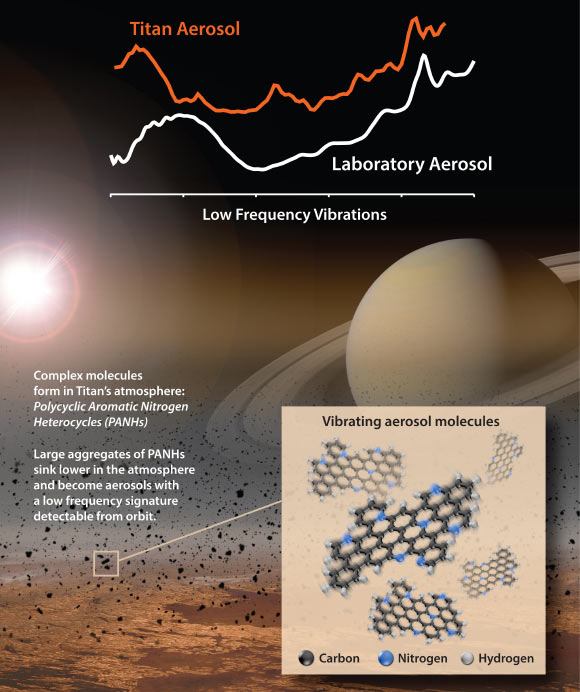The chemistry of the smoggy atmosphere of the Saturn’s largest moon, Titan, has been successfully simulated by NASA researchers in lab experiments.

This false-color mosaic, made from infrared data collected by NASA’s Cassini spacecraft, reveals the differences in the composition of surface materials around hydrocarbon lakes at Titan, Saturn’s largest moon. Titan is the only other place in the solar system that we know has stable liquid on its surface, though its lakes are made of liquid ethane and methane rather than liquid water. While there is one large lake and a few smaller ones near Titan’s south pole, almost all of Titan’s lakes appear near the moon’s north pole. Image credit: NASA / JPL-Caltech / University of Arizona / University of Idaho.
Titan‘s dirty orange color comes from a mixture of hydrocarbons (molecules that contain hydrogen and carbon) and nitrogen-carrying chemicals called nitriles. The family of hydrocarbons already has hundreds of thousands of members, identified from plants and fossil fuels on Earth, and more could exist.
A team of researchers led by Dr Joshua Sebree of NASA Goddard Space Flight Center in Greenbelt, Maryland, was able to classify a previously unidentified material discovered by Cassini spacecraft in the Titan’s atmosphere.
The material had been detected earlier in data gathered by Cassini beyond red light. The spectral signature of the material suggested it was made up of a mixture of molecules.

Scientists matched the spectral signature of an unknown material the Cassini spacecraft detected in Titan’s atmosphere at far-infrared wavelengths. The material contains aromatic hydrocarbons that include nitrogen, a subgroup called polycyclic aromatic nitrogen heterocycles. Image credit: NASA / Goddard / JPL.
To investigate that mixture, the scientists turned to the approach of combining gases in a chamber and letting them react.
The logical starting point was to begin with the two gases most plentiful in Titan’s atmosphere: nitrogen and methane. But these experiments never produced a mixture with a spectral signature to match to the one seen by Cassini.
Promising results came when the team added a third gas. The team began with benzene, which has been identified in Titan‘s atmosphere, followed by a series of closely related chemicals that are likely to be present there.
The outcome was best results were obtained when the scientists chose an aromatic that contained nitrogen.

This image is a composite of several images taken during two separate Titan flybys in 2006. The large circular feature near the center of Titan’s disk may be the remnant of a very old impact basin. The mountain ranges to the southeast of the circular feature, and the long dark, linear feature to the northwest of the old impact scar may have resulted from tectonic activity on Titan caused by the energy released when the impact occurred. Image credit: NASA/JPL/University of Arizona.
When the scientists analyzed those lab products, they detected spectral features that matched up well with the distinctive signature that had been extracted from the Titan data.
Dr Sebree, who is the first author on the paper published in the journal Icarus, concluded: “this is the closest anyone has come, to our knowledge, to recreating with lab experiments this particular feature seen in the Cassini data.
______
Joshua A. Sebree et al. 2014. Titan aerosol analog absorption features produced from aromatics in the far infrared. Icarus, vol. 236, pp. 146–152; doi: 10.1016/j.icarus.2014.03.039







